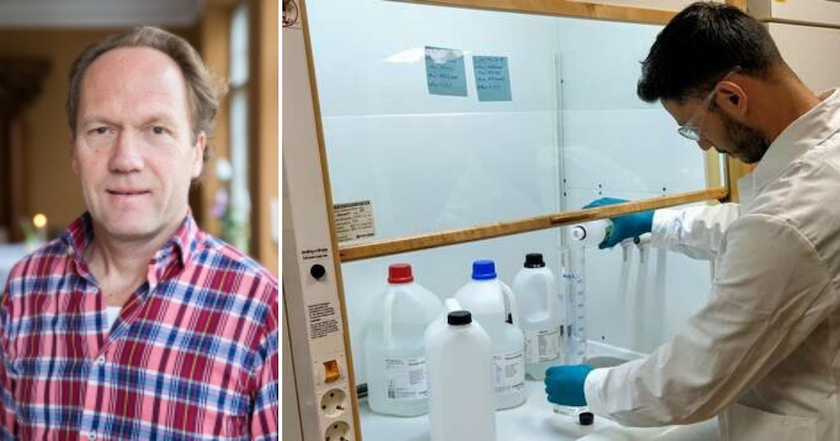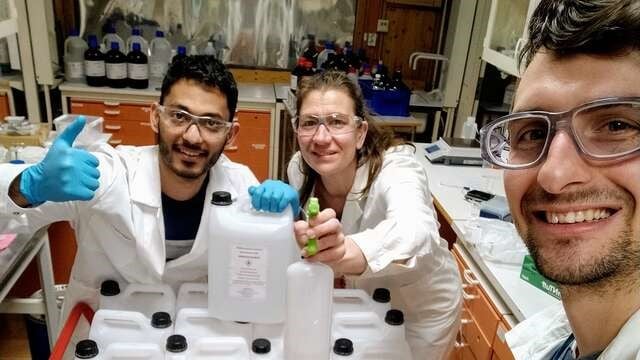From number-crunching to chemistry: how research is used in the coronavirus outbreak
As the world comes to terms with the scale of the coronavirus pandemic, confusion reigns about the reliability and relevance of many statistics. While the death toll continues to rise, the total number of infections is impossible to know and estimates of the fatality rate continue to vary.

The crisis has been made worse by shortages of essential medical supplies, which has led to chemists and other researchers at Stockholm University teaming up to solve the problem.
With no vaccine and no effective treatment, one thing that is abundantly clear is that there is no magic solution. But Tom Britton, professor of mathematics at Stockholm University and a specialist in modelling the spread of infectious diseases, says there is a magic number for public health experts to keep in mind: R = 1.
The reproduction number (R) is the number of individuals the average person with the virus infects early in an outbreak; knowing that allows models to predict its spread. Many estimates put the global reproduction number for coronavirus at 2 to 2.5. By comparison, Professor Britton says it is roughly 1.5 for flu and 15 for measles.
“With coronavirus, there’s no immunity and no vaccine, so even if R was 1.5 more than half would get infected,” he says. “At 2.5, then 60 to 70 percent would be infected if no restrictions or measures are implemented. That shows how much we must change our behaviour.”
Those changes are to help us get below the magic number: if preventive measures and increasing immunity bring the effective reproduction number below one, Professor Britton says an outbreak will soon end.
Hopes of building immunity
Professor Britton works with SIR models that map the number of people who are susceptible, infected and recovered. Chinese experts say patients with COVID-19 do develop a protective antibody – although it remains unclear how long that lasts and isolated cases of reinfection have been reported.
Evidence is also mounting that many people with coronavirus are only mildly affected. One new study suggests 17.9 per cent have no symptoms at all. For some, this stokes fears about the spread of an invisible disease. But the mathematician has a different perspective. “Essentially, that is good news because it means immunity will build up in the community quicker than we had thought,” he says.

Prof Tom Britton, Stockholm University/Photo by Konstantin Kriechbaum
Mathematical modelling of diseases starts with just a few basic parameters to understand fundamental trends. “As you make models more realistic, you add heterogeneities,” explains Professor Britton. This can make models more relevant to different societies. “For example, you divide the population into age groups and households and make assumptions about who has most contact with whom.”
Find out about opportunities to study at Stockholm University
Complete lockdowns that dramatically reduce personal contact can ensure an outbreak does not explode, as demonstrated in China, by bringing R well below 1. “But if you do it for two months and then go back to normal, coronavirus will come back,” warns Professor Britton, who is in contact with the Swedish Public Health Agency’s modelling team to offer suggestions several times per day. So, with the preventive steps taken, what does Professor Britton expect Sweden’s final rate of coronavirus infection to be?
“I think that eventually, say within a year, around 60 percent of us will get infected," he says. “The importance lies in slowing it down so that it does not happen too quickly and overburden healthcare. I also think the fatality rate is smaller than initially expected, perhaps 0.2 to 0.4 percent."
Fighting for the future
Amid warnings that COVID-19 could return annually, Stockholm University is carrying out research to develop an antiviral treatment for the coronavirus. The Fight-nCoV project is one of 17 being funded by European Union grants worth €47.5 million aimed at vaccine development, treatment and diagnostics.
Anna-Lena Spetz, professor of immunology at the Department of Molecular Biosciences, The Wenner-Gren Institute, is leading the efforts to produce a new type of antiviral drug that would also fight other viruses that attack the upper airways. Developing a “broad-spectrum” antiviral treatment also means “building preparedness for future epidemics, when the next animal-human viral transmission occurs,” says Professor Spetz.
Find out more about Stockholm University's EU grant for coronavirus research
Fight-nCoV will receive €2.8 million for two years of research. The Stockholm University team will work with colleagues in Sweden, Germany, Denmark and France to test the effect of drugs on the coronavirus in test tubes and animal models.
Chemists lend a helping hand in current healthcare crisis
In parallel to research being conducted at the University, solidarity actions and concrete help have also been part of researchers’ support in the current coronavirus crisis, for instance by Stockholm University’s chemists. The Swedish healthcare system is facing shortages of hand sanitiser and disposable protective equipment due to coronavirus.
 Photo by Konstantin Kriechbaum/Stockholm University
Photo by Konstantin Kriechbaum/Stockholm University
Chemistry Department heads spoke to one hospital and were asked if they could manufacture hand sanitiser as the demand is currently very high. Chemists began collecting the ingredients for alcohol production and set to work. In next to no time, they had a consignment of over 200 litres of hand sanitiser, as well as plastic gloves, face masks and other items.
Danderyd Hospital in Stockholm was the first to collect vital supplies and more hand sanitiser continues to be produced, destined for Karolinska University Hospital in Huddinge. “This is teamwork where many people do a fantastic job,” says Berit Olofsson, a professor of organic chemistry and section dean about the initiative, which has now spread to several other universities in Sweden following Stockholm University’s example.
This article was produced by The Local Creative Studio and sponsored by Stockholm University.
This content was paid for by an advertiser and produced by The Local's Creative Studio.

Join the conversation in our comments section below. Share your own views and experience and if you have a question or suggestion for our journalists then email us at [email protected].
Please keep comments civil, constructive and on topic – and make sure to read our terms of use before getting involved.
Please log in here to leave a comment.